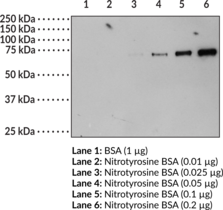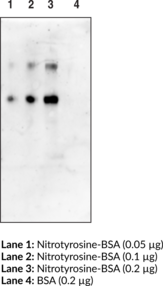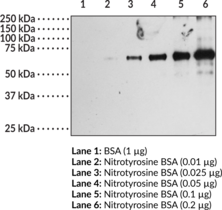Cayman
Showing 32251–32400 of 45550 results
-
Nitrosobenzene is a spin trap that has been used in the study of oxidative DNA damage and nitroso-compound-induced respiratory burst in neutrophils.{32742}
Brand:CaymanSKU:21009 -Out of stock
Nitrosobenzene is a spin trap that has been used in the study of oxidative DNA damage and nitroso-compound-induced respiratory burst in neutrophils.{32742}
Brand:CaymanSKU:21009 -Out of stock
Nitrosobenzene is a spin trap that has been used in the study of oxidative DNA damage and nitroso-compound-induced respiratory burst in neutrophils.{32742}
Brand:CaymanSKU:21009 -Out of stock
Nitrotyrosine is formed by peroxynitrite-mediated nitration of protein tyrosine residues. Its presence on proteins can be used as a marker for peroxynitrite formation in vivo.{5439,1269,4663,5357} Both free and protein-bound nitrotyrosine are commonly found in mammalian tissues and are increased in pathological conditions.{1269,7112,11380} The basal levels of free nitrotyrosine in human plasma is approximately 3 nM as determined by gas chromatography/mass spectrometry.{10970,7925}
Brand:CaymanSKU:89540 - 1 gAvailable on backorder
Nitrotyrosine is formed by peroxynitrite-mediated nitration of protein tyrosine residues. Its presence on proteins can be used as a marker for peroxynitrite formation in vivo.{5439,1269,4663,5357} Both free and protein-bound nitrotyrosine are commonly found in mammalian tissues and are increased in pathological conditions.{1269,7112,11380} The basal levels of free nitrotyrosine in human plasma is approximately 3 nM as determined by gas chromatography/mass spectrometry.{10970,7925}
Brand:CaymanSKU:89540 - 10 gAvailable on backorder
Nitrotyrosine is formed by peroxynitrite-mediated nitration of protein tyrosine residues. Its presence on proteins can be used as a marker for peroxynitrite formation in vivo.{5439,1269,4663,5357} Both free and protein-bound nitrotyrosine are commonly found in mammalian tissues and are increased in pathological conditions.{1269,7112,11380} The basal levels of free nitrotyrosine in human plasma is approximately 3 nM as determined by gas chromatography/mass spectrometry.{10970,7925}
Brand:CaymanSKU:89540 - 25 gAvailable on backorder
Nitrotyrosine is formed by peroxynitrite-mediated nitration of protein tyrosine residues. Its presence on proteins can be used as a marker for peroxynitrite formation in vivo.{5439,1269,4663,5357} Both free and protein-bound nitrotyrosine are commonly found in mammalian tissues and are increased in pathological conditions.{1269,7112,11380} The basal levels of free nitrotyrosine in human plasma is approximately 3 nM as determined by gas chromatography/mass spectrometry.{10970,7925}
Brand:CaymanSKU:89540 - 5 gAvailable on backorder
Immunogen: Nitrotyrosine-containing synthetic peptide • Host: Rabbit • Species Reactivity: (+) Species independent • Applications: WB,,
Brand:CaymanSKU:10006778- 500 µlAvailable on backorder
Immunogen: Nitrotyrosine-containing synthetic peptide • Host: Rabbit • Species Reactivity: (+) Species independent • Applications: WB,,
Brand:CaymanSKU:10006778- 500 µlNitrotyrosine is a post-translational modification that is formed by the nitration of tyrosine.{60009} Under conditions of oxidative stress, tyrosine is oxidized by reactive oxygen species (ROS) or, in the presence of hydrogen peroxide and nitrite, by myeloperoxidase (MPO) to yield a tyrosine radical that reacts with reactive nitrogen species (RNS), such as nitric oxide or peroxynitrite, to form nitrotyrosine. It exists in a free or protein-bound form and is commonly used as a marker of nitrosative or oxidative stress.{31710} Nitrotyrosine residues have been found in a variety of proteins, including LDL, surfactant protein A, angiotensin II, and human and bovine serum albumin.{60010} Free nitrotyrosine production induced by peroxynitrite is inhibited by the polyphenols epicatechin gallate, gallic acid, catechin, or epicatechin in cell-free assays, as well as in aortic rings isolated from normotensive and spontaneously hypertensive rats administered the antioxidant N-acetyl-cysteine (NAC; Item No. 20261).{60011,60012} Nitrotyrosine levels are increased in the affected tissues of numerous pathological conditions, including atherosclerosis, cancer, ulcerative colitis, Alzheimer’s disease, and Parkinson’s disease.{60010} Autoantibodies that recognize nitrotyrosinated proteins are increased in the synovium of patients with rheumatoid arthritis and are positively correlated with joint and tendon inflammation.{60009} Cayman’s Nitrotyrosine (Peptide) Polyclonal Antibody has been prepared by affinity purification to exclude non-nitrotyrosine antibodies generated against the antigenic peptide backbone. This antibody can be used for Western blot (WB) applications.
Brand:CaymanSKU:10006778 - 500 µlAvailable on backorder
Immunogen: Peroxynitrite-treated keyhole limpet hemocyanin • Host: Mouse • Species Reactivity: (+) Species independent • Applications: ELISA, WB
Brand:CaymanSKU:189542- 200 µgAvailable on backorder
Immunogen: Peroxynitrite-treated keyhole limpet hemocyanin • Host: Mouse • Species Reactivity: (+) Species independent • Applications: ELISA, WB
Brand:CaymanSKU:189542- 200 µgNitrotyrosine is a post-translational modification that is formed by the nitration of tyrosine.{60009} Under conditions of oxidative stress, tyrosine is oxidized by reactive oxygen species (ROS) or, in the presence of hydrogen peroxide and nitrite, by myeloperoxidase (MPO) to yield a tyrosine radical that reacts with reactive nitrogen species (RNS), such as nitric oxide or peroxynitrite, to form nitrotyrosine. It exists in a free or protein-bound form and is commonly used as a marker of nitrosative or oxidative stress.{31710} Nitrotyrosine residues have been found in a variety of proteins, including LDL, surfactant protein A, angiotensin II, and human and bovine serum albumin.{60010} Free nitrotyrosine production induced by peroxynitrite is inhibited by the polyphenols epicatechin gallate, gallic acid, catechin, or epicatechin in cell-free assays, as well as in aortic rings isolated from normotensive and spontaneously hypertensive rats administered the antioxidant N-acetyl-cysteine (NAC; Item No. 20261).{60011,60012} Nitrotyrosine levels are increased in the affected tissues of numerous pathological conditions, including atherosclerosis, cancer, ulcerative colitis, Alzheimer’s disease, and Parkinson’s disease.{60010} Autoantibodies that recognize nitrotyrosinated proteins are increased in the synovium of patients with rheumatoid arthritis and are positively correlated with joint and tendon inflammation.{60009} Cayman’s Nitrotyrosine Monoclonal Antibody can be used for ELISA and Western blot (WB) applications.
Brand:CaymanSKU:189542 - 200 µgAvailable on backorder
Immunogen: Peroxynitrite-treated keyhole limpet hemocyanin • Host: Mouse • Species Reactivity: (+) Species independent • Applications: ELISA, WB
Brand:CaymanSKU:189542- 50 µgAvailable on backorder
Immunogen: Peroxynitrite-treated keyhole limpet hemocyanin • Host: Mouse • Species Reactivity: (+) Species independent • Applications: ELISA, WB
Brand:CaymanSKU:189542- 50 µgNitrotyrosine is a post-translational modification that is formed by the nitration of tyrosine.{60009} Under conditions of oxidative stress, tyrosine is oxidized by reactive oxygen species (ROS) or, in the presence of hydrogen peroxide and nitrite, by myeloperoxidase (MPO) to yield a tyrosine radical that reacts with reactive nitrogen species (RNS), such as nitric oxide or peroxynitrite, to form nitrotyrosine. It exists in a free or protein-bound form and is commonly used as a marker of nitrosative or oxidative stress.{31710} Nitrotyrosine residues have been found in a variety of proteins, including LDL, surfactant protein A, angiotensin II, and human and bovine serum albumin.{60010} Free nitrotyrosine production induced by peroxynitrite is inhibited by the polyphenols epicatechin gallate, gallic acid, catechin, or epicatechin in cell-free assays, as well as in aortic rings isolated from normotensive and spontaneously hypertensive rats administered the antioxidant N-acetyl-cysteine (NAC; Item No. 20261).{60011,60012} Nitrotyrosine levels are increased in the affected tissues of numerous pathological conditions, including atherosclerosis, cancer, ulcerative colitis, Alzheimer’s disease, and Parkinson’s disease.{60010} Autoantibodies that recognize nitrotyrosinated proteins are increased in the synovium of patients with rheumatoid arthritis and are positively correlated with joint and tendon inflammation.{60009} Cayman’s Nitrotyrosine Monoclonal Antibody can be used for ELISA and Western blot (WB) applications.
Brand:CaymanSKU:189542 - 50 µgAvailable on backorder
Nitrotyrosine is a post-translational modification that is formed by the nitration of tyrosine.{60009} Under conditions of oxidative stress, tyrosine is oxidized by reactive oxygen species (ROS) or, in the presence of hydrogen peroxide and nitrite, by myeloperoxidase (MPO) to yield a tyrosine radical that reacts with reactive nitrogen species (RNS), such as nitric oxide or peroxynitrite, to form nitrotyrosine. It exists in a free or protein-bound form and is commonly used as a marker of nitrosative or oxidative stress.{31710} Nitrotyrosine residues have been found in a variety of proteins, including LDL, surfactant protein A, angiotensin II, and human and bovine serum albumin.{60010} Free nitrotyrosine production induced by peroxynitrite is inhibited by the polyphenols epicatechin gallate, gallic acid, catechin, or epicatechin in cell-free assays, as well as in aortic rings isolated from normotensive and spontaneously hypertensive rats administered the antioxidant N-acetyl-cysteine (NAC; Item No. 20261).{60011,60012} Nitrotyrosine levels are increased in the affected tissues of numerous pathological conditions, including atherosclerosis, cancer, ulcerative colitis, Alzheimer’s disease, and Parkinson’s disease.{60010} Autoantibodies that recognize nitrotyrosinated proteins are increased in the synovium of patients with rheumatoid arthritis and are positively correlated with joint and tendon inflammation.{60009} Cayman’s Nitrotyrosine Monoclonal Antibody – Biotinylated can be used for ELISA or Western blot (WB) applications.
Brand:CaymanSKU:10006966 - 100 µgAvailable on backorder
Immunogen: Peroxynitrite-treated keyhole limpet hemocyanin • Host: Mouse • Species Reactivity: Species independent • Cross Reactivity: (+) Chlorotyrosine (weakly) • Applications: ELISA, WB
Brand:CaymanSKU:10006966- 100 µgAvailable on backorder
Immunogen: Peroxynitrite-treated keyhole limpet hemocyanin • Host: Mouse • Species Reactivity: Species independent • Cross Reactivity: (+) Chlorotyrosine (weakly) • Applications: ELISA, WB
Brand:CaymanSKU:10006966- 100 µgImmunogen: Peroxynitrite-treated keyhole limpet hemocyanin • Host: Rabbit • Species Reactivity: (+) Species independent • Cross Reactivity: None listed • Applications: WB
Brand:CaymanSKU:10189540- 1 eaNitrotyrosine is a post-translational modification that is formed by the nitration of tyrosine.{60009} Under conditions of oxidative stress, tyrosine is oxidized by reactive oxygen species (ROS) or, in the presence of hydrogen peroxide and nitrite, by myeloperoxidase (MPO) to yield a tyrosine radical that reacts with reactive nitrogen species (RNS), such as nitric oxide or peroxynitrite, to form nitrotyrosine. It exists in a free or protein-bound form and is commonly used as a marker of nitrosative or oxidative stress.{31710} Nitrotyrosine residues have been found in a variety of proteins, including LDL, surfactant protein A, angiotensin II, and human and bovine serum albumin.{60010} Free nitrotyrosine production induced by peroxynitrite is inhibited by the polyphenols epicatechin gallate, gallic acid, catechin, or epicatechin in cell-free assays, as well as in aortic rings isolated from normotensive and spontaneously hypertensive rats administered the antioxidant N-acetyl-cysteine (NAC; Item No. 20261).{60011,60012} Nitrotyrosine levels are increased in the affected tissues of numerous pathological conditions, including atherosclerosis, cancer, ulcerative colitis, Alzheimer’s disease, and Parkinson’s disease.{60010} Autoantibodies that recognize nitrotyrosinated proteins are increased in the synovium of patients with rheumatoid arthritis and are positively correlated with joint and tendon inflammation.{60009} Cayman’s Nitrotyrosine Polyclonal Antibody can be used for Western blot (WB) applications.
Brand:CaymanSKU:10189540 - 1 eaAvailable on backorder
Immunogen: Peroxynitrite-treated keyhole limpet hemocyanin • Host: Rabbit • Species Reactivity: (+) Species independent • Cross Reactivity: None listed • Applications: WB
Brand:CaymanSKU:10189540- 1 eaAvailable on backorder
Nitroxoline is an 8-hydroxyquinoline that has diverse biological activities, including antibacterial, antiproliferative, and bromodomain interaction-inhibiting properties.{45442,45443,45444,45445} Nitroxoline is active against the bacteria E. coli, S. aureus, E. faecalis, K. pneumoniae, and P. mirabilis in vitro (MIC90s = 4, 4, 8, 8, and 8 mg/L, respectively).{45442} It also inhibits biofilm formation of certain strains of multidrug-resistant (MDR) A. baumannii and P. aeruginosa, as well as methicillin-resistant S. aureus (MRSA) and S. epidermidis (MRSE) with minimum biofilm eradication concentration (MBEC) values of 46.9, 1,500, 188, and 125 μM, respectively.{45443} Nitroxoline inhibits the growth of human U87 and U251 glioma, A549 lung, and PC3 prostate cancer cells (IC50s = 50, 6, 38, and 23 μg/ml, respectively).{45444} In vivo, it reduces tumor growth in a PTEN- and KRAS-driven glioma mouse model when administered at a dose of 80 mg/kg per day. Nitroxoline also inhibits the interaction between the first bromodomain of bromodomain-containing protein 4 (BRD4) with acetylated histone H4 with an IC50 value of 0.98 μM.{45445}
Brand:CaymanSKU:28391 - 10 gAvailable on backorder
Nitroxoline is an 8-hydroxyquinoline that has diverse biological activities, including antibacterial, antiproliferative, and bromodomain interaction-inhibiting properties.{45442,45443,45444,45445} Nitroxoline is active against the bacteria E. coli, S. aureus, E. faecalis, K. pneumoniae, and P. mirabilis in vitro (MIC90s = 4, 4, 8, 8, and 8 mg/L, respectively).{45442} It also inhibits biofilm formation of certain strains of multidrug-resistant (MDR) A. baumannii and P. aeruginosa, as well as methicillin-resistant S. aureus (MRSA) and S. epidermidis (MRSE) with minimum biofilm eradication concentration (MBEC) values of 46.9, 1,500, 188, and 125 μM, respectively.{45443} Nitroxoline inhibits the growth of human U87 and U251 glioma, A549 lung, and PC3 prostate cancer cells (IC50s = 50, 6, 38, and 23 μg/ml, respectively).{45444} In vivo, it reduces tumor growth in a PTEN- and KRAS-driven glioma mouse model when administered at a dose of 80 mg/kg per day. Nitroxoline also inhibits the interaction between the first bromodomain of bromodomain-containing protein 4 (BRD4) with acetylated histone H4 with an IC50 value of 0.98 μM.{45445}
Brand:CaymanSKU:28391 - 25 gAvailable on backorder
Nitroxoline is an 8-hydroxyquinoline that has diverse biological activities, including antibacterial, antiproliferative, and bromodomain interaction-inhibiting properties.{45442,45443,45444,45445} Nitroxoline is active against the bacteria E. coli, S. aureus, E. faecalis, K. pneumoniae, and P. mirabilis in vitro (MIC90s = 4, 4, 8, 8, and 8 mg/L, respectively).{45442} It also inhibits biofilm formation of certain strains of multidrug-resistant (MDR) A. baumannii and P. aeruginosa, as well as methicillin-resistant S. aureus (MRSA) and S. epidermidis (MRSE) with minimum biofilm eradication concentration (MBEC) values of 46.9, 1,500, 188, and 125 μM, respectively.{45443} Nitroxoline inhibits the growth of human U87 and U251 glioma, A549 lung, and PC3 prostate cancer cells (IC50s = 50, 6, 38, and 23 μg/ml, respectively).{45444} In vivo, it reduces tumor growth in a PTEN- and KRAS-driven glioma mouse model when administered at a dose of 80 mg/kg per day. Nitroxoline also inhibits the interaction between the first bromodomain of bromodomain-containing protein 4 (BRD4) with acetylated histone H4 with an IC50 value of 0.98 μM.{45445}
Brand:CaymanSKU:28391 - 5 gAvailable on backorder
Nivalenol is a trichothecene mycotoxin that has been found in Fusarium.{32197} It is lethal to mice (LD50 = 6.9 mg/kg).{59482} Nivalenol (5, 10, and 15 mg/kg) also induces thymic, splenic, and Peyer’s patch cell apoptosis in mice.{59483}
Brand:CaymanSKU:11438 - 1 mgAvailable on backorder
Nivalenol is a trichothecene mycotoxin that has been found in Fusarium.{32197} It is lethal to mice (LD50 = 6.9 mg/kg).{59482} Nivalenol (5, 10, and 15 mg/kg) also induces thymic, splenic, and Peyer’s patch cell apoptosis in mice.{59483}
Brand:CaymanSKU:11438 - 5 mgAvailable on backorder
Histamine H2 receptors mediate gastric acid secretion by coupling to Gαs proteins and increasing cAMP formation. Nizatidine is a histamine H2 receptor antagonist that decreases gastric acid secretion (ED50 = 0.9 µM in isolated gastric mucosa of bullfrog and ED50s = 1.383 and 0.08 μmol/kg in rats and dogs, respectively).{30545} Its gastroprotective activity has been exploited in clinical studies of various gastric acid disorders.{27475,27473}
Brand:CaymanSKU:-Available on backorder
Histamine H2 receptors mediate gastric acid secretion by coupling to Gαs proteins and increasing cAMP formation. Nizatidine is a histamine H2 receptor antagonist that decreases gastric acid secretion (ED50 = 0.9 µM in isolated gastric mucosa of bullfrog and ED50s = 1.383 and 0.08 μmol/kg in rats and dogs, respectively).{30545} Its gastroprotective activity has been exploited in clinical studies of various gastric acid disorders.{27475,27473}
Brand:CaymanSKU:-Available on backorder
Histamine H2 receptors mediate gastric acid secretion by coupling to Gαs proteins and increasing cAMP formation. Nizatidine is a histamine H2 receptor antagonist that decreases gastric acid secretion (ED50 = 0.9 µM in isolated gastric mucosa of bullfrog and ED50s = 1.383 and 0.08 μmol/kg in rats and dogs, respectively).{30545} Its gastroprotective activity has been exploited in clinical studies of various gastric acid disorders.{27475,27473}
Brand:CaymanSKU:-Available on backorder
Histamine H2 receptors mediate gastric acid secretion by coupling to Gαs proteins and increasing cAMP formation. Nizatidine is a histamine H2 receptor antagonist that decreases gastric acid secretion (ED50 = 0.9 µM in isolated gastric mucosa of bullfrog and ED50s = 1.383 and 0.08 μmol/kg in rats and dogs, respectively).{30545} Its gastroprotective activity has been exploited in clinical studies of various gastric acid disorders.{27475,27473}
Brand:CaymanSKU:-Available on backorder
NK 252 is a Nrf2 activator that interacts directly with the domain containing the Nrf2-binding site of Keap1.{31236} At 1.36 µM, it is reported to activate the NQO1-antioxidant response element in a luciferase reporter gene assay two-fold above background.{31236} NK 252 has been shown to downregulate the expression of fibrogenic genes, producing antifibrotic effects in a rat model of non-alcoholic steatohepatitis.{31236}
Brand:CaymanSKU:-Available on backorder
NK 252 is a Nrf2 activator that interacts directly with the domain containing the Nrf2-binding site of Keap1.{31236} At 1.36 µM, it is reported to activate the NQO1-antioxidant response element in a luciferase reporter gene assay two-fold above background.{31236} NK 252 has been shown to downregulate the expression of fibrogenic genes, producing antifibrotic effects in a rat model of non-alcoholic steatohepatitis.{31236}
Brand:CaymanSKU:-Available on backorder
NK 252 is a Nrf2 activator that interacts directly with the domain containing the Nrf2-binding site of Keap1.{31236} At 1.36 µM, it is reported to activate the NQO1-antioxidant response element in a luciferase reporter gene assay two-fold above background.{31236} NK 252 has been shown to downregulate the expression of fibrogenic genes, producing antifibrotic effects in a rat model of non-alcoholic steatohepatitis.{31236}
Brand:CaymanSKU:-Available on backorder
NK 252 is a Nrf2 activator that interacts directly with the domain containing the Nrf2-binding site of Keap1.{31236} At 1.36 µM, it is reported to activate the NQO1-antioxidant response element in a luciferase reporter gene assay two-fold above background.{31236} NK 252 has been shown to downregulate the expression of fibrogenic genes, producing antifibrotic effects in a rat model of non-alcoholic steatohepatitis.{31236}
Brand:CaymanSKU:-Available on backorder
Forskolin (Item No. 11018) is a potent activator of adenylyl cyclase, but it is sparingly soluble in aqueous solutions. NKH477 is a water-soluble analog of forskolin which has both inotropic and vasodilator effects when administered intravenously.{20477,20480,20481} Like forskolin, NKH477 activates adenylyl cyclases without altering the activity of phosphodiesterases or sodium/potassium ATPases.{20477} This compound stimulates cardiac (type V) adenylyl cyclase more potently than other isoforms.{20482} NKH477 relaxes guinea pig tracheal smooth muscle precontracted with histamine with an EC50 value of 32.6 nM.{20481}
Brand:CaymanSKU:11214 - 1 mgAvailable on backorder
Forskolin (Item No. 11018) is a potent activator of adenylyl cyclase, but it is sparingly soluble in aqueous solutions. NKH477 is a water-soluble analog of forskolin which has both inotropic and vasodilator effects when administered intravenously.{20477,20480,20481} Like forskolin, NKH477 activates adenylyl cyclases without altering the activity of phosphodiesterases or sodium/potassium ATPases.{20477} This compound stimulates cardiac (type V) adenylyl cyclase more potently than other isoforms.{20482} NKH477 relaxes guinea pig tracheal smooth muscle precontracted with histamine with an EC50 value of 32.6 nM.{20481}
Brand:CaymanSKU:11214 - 10 mgAvailable on backorder
Forskolin (Item No. 11018) is a potent activator of adenylyl cyclase, but it is sparingly soluble in aqueous solutions. NKH477 is a water-soluble analog of forskolin which has both inotropic and vasodilator effects when administered intravenously.{20477,20480,20481} Like forskolin, NKH477 activates adenylyl cyclases without altering the activity of phosphodiesterases or sodium/potassium ATPases.{20477} This compound stimulates cardiac (type V) adenylyl cyclase more potently than other isoforms.{20482} NKH477 relaxes guinea pig tracheal smooth muscle precontracted with histamine with an EC50 value of 32.6 nM.{20481}
Brand:CaymanSKU:11214 - 5 mgAvailable on backorder
NKY80 is a cell-permeable inhibitor of adenylyl cyclase (AC) that is selective for isoform AC5 over AC2 and AC3 (IC50s = 8.3 μM, 1.7 mM, and 132 μM, respectively in the presence of Gsα GTPγS-forskolin).{28956} It is a non-competitive inhibitor with respect to ATP (Item No. 14498) and forskolin (Item No. 11018) and tissue selective for AC catalytic activity in heart and lung.{28956}
Brand:CaymanSKU:-Available on backorder
NKY80 is a cell-permeable inhibitor of adenylyl cyclase (AC) that is selective for isoform AC5 over AC2 and AC3 (IC50s = 8.3 μM, 1.7 mM, and 132 μM, respectively in the presence of Gsα GTPγS-forskolin).{28956} It is a non-competitive inhibitor with respect to ATP (Item No. 14498) and forskolin (Item No. 11018) and tissue selective for AC catalytic activity in heart and lung.{28956}
Brand:CaymanSKU:-Available on backorder
NKY80 is a cell-permeable inhibitor of adenylyl cyclase (AC) that is selective for isoform AC5 over AC2 and AC3 (IC50s = 8.3 μM, 1.7 mM, and 132 μM, respectively in the presence of Gsα GTPγS-forskolin).{28956} It is a non-competitive inhibitor with respect to ATP (Item No. 14498) and forskolin (Item No. 11018) and tissue selective for AC catalytic activity in heart and lung.{28956}
Brand:CaymanSKU:-Available on backorder
NKY80 is a cell-permeable inhibitor of adenylyl cyclase (AC) that is selective for isoform AC5 over AC2 and AC3 (IC50s = 8.3 μM, 1.7 mM, and 132 μM, respectively in the presence of Gsα GTPγS-forskolin).{28956} It is a non-competitive inhibitor with respect to ATP (Item No. 14498) and forskolin (Item No. 11018) and tissue selective for AC catalytic activity in heart and lung.{28956}
Brand:CaymanSKU:-Available on backorder
NLRP3i is an intermediate in the synthesis of glyburide (Item No. 15009) and an inhibitor of the NOD-, LRR-, and pyrin domain-containing protein 3 (NLRP3) inflammasome.{54178} It is selective for NLRP3 over NLRP4 and absent in melanoma 2 (AIM2) inflammasomes at 400 µM. NLRPi inhibits LPS-induced IL-1β release and apoptosis-associated speck-like protein containing a CARD (ASC) oligomerization in J774A.1 mouse macrophages. In vivo, NLRP3i (100 mg/kg) reduces infarct size and cardiac levels of troponin I in a mouse model of acute myocardial infarction. It reduces peritoneal leukocyte infiltration in a mouse model of peritonitis induced by zymosan A (Item No. 21175) in a dose-dependent manner. NLRP3i (100 mg/kg) also decreases plasma IL-18 levels and reduces systolic and diastolic dysfunction in a mouse model of Western diet-induced obesity.{54179}
Brand:CaymanSKU:30895 - 1 gAvailable on backorder
NMDA is a synthetic amino acid derivative that acts as a specific agonist at the NMDA receptor, mimicking the excitatory action of the endogenous ligand glutamate.{14636,11801} Signaling through the NMDA receptor influences both neuronal plasticity and neurotoxicity.{7059} Repetitive activation of NMDA synapses leads to long-term potentiation, which is used as a model of learning and the initial stages of memory formation.{5566}
Brand:CaymanSKU:-NMDA is a synthetic amino acid derivative that acts as a specific agonist at the NMDA receptor, mimicking the excitatory action of the endogenous ligand glutamate.{14636,11801} Signaling through the NMDA receptor influences both neuronal plasticity and neurotoxicity.{7059} Repetitive activation of NMDA synapses leads to long-term potentiation, which is used as a model of learning and the initial stages of memory formation.{5566}
Brand:CaymanSKU:-NMDA is a synthetic amino acid derivative that acts as a specific agonist at the NMDA receptor, mimicking the excitatory action of the endogenous ligand glutamate.{14636,11801} Signaling through the NMDA receptor influences both neuronal plasticity and neurotoxicity.{7059} Repetitive activation of NMDA synapses leads to long-term potentiation, which is used as a model of learning and the initial stages of memory formation.{5566}
Brand:CaymanSKU:-NMDA is a synthetic amino acid derivative that acts as a specific agonist at the NMDA receptor, mimicking the excitatory action of the endogenous ligand glutamate.{14636,11801} Signaling through the NMDA receptor influences both neuronal plasticity and neurotoxicity.{7059} Repetitive activation of NMDA synapses leads to long-term potentiation, which is used as a model of learning and the initial stages of memory formation.{5566}
Brand:CaymanSKU:-Antigen: fusion protein containing amino acids 1-564 of the NR1 subunit of rat NMDA receptor • Host: mouse • Cross Reactivity: (+) rat and mouse NMDA receptor • Application(s): IP and WB • The NMDAR plays an essential role in memory, neuronal development and it has also been implicated in several disorders of the central nervous system including Alzheimer’s, epilepsy and ischemic neuronal cell death. The NR1 protein can form NMDA activated channels when expressed in Xenopus oocytes but the currents in such channels are much smaller than those seen in situ.
Brand:CaymanSKU:10607- 1 eaThe ion channels activated by glutamate are typically divided into two classes. Glutamate receptors that are activated by kainate and α-amino-3-hydroxy-5-methyl-4-isoxalone propionic acid (AMPA) are known as kainate/AMPA receptors (K/AMPAR). Those that are sensitive to Nmethyl- D-aspartate (NMDA) are designated NMDA receptors (NMDAR). The NMDAR plays an essential role in memory, neuronal development and it has also been implicated in several disorders of the central nervous system including Alzheimer’s, epilepsy and ischemic neuronal cell death. The NMDA receptor is also one of the principal molecular targets for alcohol in the CNS. The NMDAR is also potentiated by protein phosphorylation. The rat NMDAR1 (NR1) was the first subunit of the NMDAR to be cloned. The NR1 protein can form NMDA activated channels when expressed in Xenopus oocytes but the currents in such channels are much smaller than those seen in situ. Channels with more physiological characteristics are produced when the NR1-subunit is combined with one or more of the NMDAR2 (NR2 A-D) subunits.
Brand:CaymanSKU:10607 - 1 eaAvailable on backorder
Antigen: fusion protein containing amino acids 1-564 of the NR1 subunit of rat NMDA receptor • Host: mouse • Cross Reactivity: (+) rat and mouse NMDA receptor • Application(s): IP and WB • The NMDAR plays an essential role in memory, neuronal development and it has also been implicated in several disorders of the central nervous system including Alzheimer’s, epilepsy and ischemic neuronal cell death. The NR1 protein can form NMDA activated channels when expressed in Xenopus oocytes but the currents in such channels are much smaller than those seen in situ.
Brand:CaymanSKU:10607- 1 eaAvailable on backorder
Antigen: fusion protein from the C-terminus of the NR2A subunit of rat NMDA receptor • Host: rabbit • Cross Reactivity: (+) human, mouse, and rat NMDA receptor • Application(s): IHC, IP, and WB • The NMDAR plays an essential role in memory, neuronal development and it has also been implicated in several disorders of the central nervous system including Alzheimer’s, epilepsy and ischemic neuronal cell death. Channels with physiological activity are produced when the NR1 subunit is combined with one or more of the NMDAR2 (NR2 A-D) subunits.
Brand:CaymanSKU:10608- 1 eaThe ion channels activated by glutamate are typically divided into two classes. Glutamate receptors that are activated by kainate and α-amino-3-hydroxy-5-methyl-4-isoxalone propionic acid (AMPA) are known as kainate/AMPA receptors (K/AMPAR). Those that are sensitive to N-methyl-Daspartate (NMDA) are designated NMDA receptors (NMDAR). The NMDAR plays an essential role in memory, neuronal development and it has also been implicated in several disorders of the central nervous system including Alzheimer’s, epilepsy and ischemic neuronal cell death. The NMDA receptor is also one of the principal molecular targets for alcohol in the CNS. The NMDAR is also potentiated by protein phosphorylation. The rat NMDAR1 (NR1) was the first subunit of the NMDAR to be cloned. The NR1 protein can form NMDA activated channels when expressed in Xenopus oocytes but the currents in such channels are much smaller than those seen in situ. Channels with more physiological characteristics are produced when the NR1 subunit is combined with one or more of the NMDAR2 (NR2 A-D) subunits.
Brand:CaymanSKU:10608 - 1 eaAvailable on backorder
Antigen: fusion protein from the C-terminus of the NR2A subunit of rat NMDA receptor • Host: rabbit • Cross Reactivity: (+) human, mouse, and rat NMDA receptor • Application(s): IHC, IP, and WB • The NMDAR plays an essential role in memory, neuronal development and it has also been implicated in several disorders of the central nervous system including Alzheimer’s, epilepsy and ischemic neuronal cell death. Channels with physiological activity are produced when the NR1 subunit is combined with one or more of the NMDAR2 (NR2 A-D) subunits.
Brand:CaymanSKU:10608- 1 eaAvailable on backorder
The NMDA receptor (NMDAR) plays an essential role in memory, neuronal development, and it has also been implicated in several disorders of the central nervous system including Alzheimer’s disease, epilepsy, and ischemic neuronal death. {14637,14639,14638} The NR1 protein can form NMDA activated channels when expressed in Xenopus oocytes but the currents in such channels are much smaller than those seen in situ. Channels with more physiological characteristics are produced when the NR1 subunit is combined with one or more of the NMDAR2 (NR2 A-D) subunits. {14636} Phosphorylation of Tyr1252 in NR2B is thought to potentiate NMDA receptor-dependent influx of calcium.{14640}
Brand:CaymanSKU:10009759 - 1 eaAvailable on backorder
Antigen: phosphopeptide corresponding to amino acid residues surrounding phospho-Tyr1252 of the human NMDA Receptor NR2B Subunit • Host: rabbit • Cross Reactivity: (+) human and rat NMDA receptor; expected to react with bovine, canine, chicken, mouse, non-human primates, and zebrafish NMDA receptor • Application(s): WB • Phosphorylation of Tyr1252 in NR2B is thought to potentiate NMDA receptor-dependent influx of calcium.
Brand:CaymanSKU:10009759- 1 eaAvailable on backorder
Antigen: phosphopeptide corresponding to amino acid residues surrounding phospho-Tyr1252 of the human NMDA Receptor NR2B Subunit • Host: rabbit • Cross Reactivity: (+) human and rat NMDA receptor; expected to react with bovine, canine, chicken, mouse, non-human primates, and zebrafish NMDA receptor • Application(s): WB • Phosphorylation of Tyr1252 in NR2B is thought to potentiate NMDA receptor-dependent influx of calcium.
Brand:CaymanSKU:10009759- 1 eaThe NMDA receptor (NMDAR) plays an essential role in memory, neuronal development, and it has also been implicated in several disorders of the central nervous system including Alzheimer’s disease, epilepsy, and ischemic neuronal death. {14637,14639,14638} The NR1 protein can form NMDA activated channels when expressed in Xenopus oocytes but the currents in such channels are much smaller than those seen in situ. Channels with more physiological characteristics are produced when the NR1 subunit is combined with one or more of the NMDAR2 (NR2 A-D) subunits. {14636} Phosphorylation of Tyr1336 in NR2B is thought to potentiate NMDA receptor-dependent influx of calcium.{14640} Ischemia may also increase the phosphorylation of this site.
Brand:CaymanSKU:10009760 - 1 eaAvailable on backorder
Antigen: phosphopeptide corresponding to amino acid residues surrounding phospho-Tyr1336 of the human NMDA Receptor NR2B Subunit • Host: rabbit • Cross Reactivity: (+) human and rat NMDA receptor; expected to react with bovine, canine, chicken, mouse, non-human primates, and zebrafish NMDA receptor • Application(s): WB • Phosphorylation of Tyr1336 in NR2B is thought to potentiate NMDA receptor-dependent influx of calcium. Ischemia may also increase the phosphorylation of this site.
Brand:CaymanSKU:10009760- 1 eaAvailable on backorder
Antigen: phosphopeptide corresponding to amino acid residues surrounding phospho-Tyr1336 of the human NMDA Receptor NR2B Subunit • Host: rabbit • Cross Reactivity: (+) human and rat NMDA receptor; expected to react with bovine, canine, chicken, mouse, non-human primates, and zebrafish NMDA receptor • Application(s): WB • Phosphorylation of Tyr1336 in NR2B is thought to potentiate NMDA receptor-dependent influx of calcium. Ischemia may also increase the phosphorylation of this site.
Brand:CaymanSKU:10009760- 1 eaThe NMDA receptor (NMDAR) plays an essential role in memory, neuronal development and it has also been implicated in several disorders of the central nervous system including Alzheimer’s disease, epilepsy and ischemic neuronal death. {14637,14639,14638} The NMDA receptor is also one of the principal molecular targets for alcohol in the CNS. {14643,14633,14645} Channels with physiological characteristics are produced when the NR1 subunit is combined with one or more of the NMDAR2 (NR2 A-D) subunits. {14636} Overexpression of the NR2B-subunit of the NMDA Receptor has been associated with increases in learning and memory while aged, memory impaired animals have deficiencies in NR2B expression. {14635,14641} Recent work suggests that phosphorylation of Tyr1472 on NR2B may regulate the functional expression of the receptor in LTP and other forms of plasticity. {14634,14644}
Brand:CaymanSKU:10009761 - 1 eaAvailable on backorder
Antigen: phosphopeptide corresponding to amino acid residues surrounding phospho-Tyr1472 of NMDA Receptor NR2B Subunit • Host: rabbit • Cross Reactivity: (+) human and rat NMDA receptor; expected to react with bovine, canine, chicken, mouse, non-human primates, and zebrafish NMDA receptor • Application(s): WB • Phosphorylation of Tyr1472 on NR2B may regulate the functional expression of the receptor in LTP and other forms of plasticity.
Brand:CaymanSKU:10009761- 1 eaAvailable on backorder
Antigen: phosphopeptide corresponding to amino acid residues surrounding phospho-Tyr1472 of NMDA Receptor NR2B Subunit • Host: rabbit • Cross Reactivity: (+) human and rat NMDA receptor; expected to react with bovine, canine, chicken, mouse, non-human primates, and zebrafish NMDA receptor • Application(s): WB • Phosphorylation of Tyr1472 on NR2B may regulate the functional expression of the receptor in LTP and other forms of plasticity.
Brand:CaymanSKU:10009761- 1 eaAntigen: fusion protein from the C-terminus of the NR2B subunit of rat NMDA receptor • Host: rabbit • Cross Reactivity: (+) human, rat, and mouse NMDA receptor • Application(s): IHC, IP, and WB • Overexpression of the NR2B-subunit of the NMDA receptor has been associated with increases in learning and memory while aged, memory impaired animals have deficiencies in NR2B expression.
Brand:CaymanSKU:10609- 1 eaThe ion channels activated by glutamate that are sensitive to N-methyl-D-aspartate (NMDA) are designated NMDA receptors (NMDAR). The NMDAR plays an essential role in memory, neuronal development and it has also been implicated in several disorders of the central nervous system including Alzheimer’s, epilepsy. and ischemic neuronal cell death. The NMDA receptor is also one of the principal molecular targets for alcohol in the CNS. The rat NMDAR1 (NR1) was the first subunit of the NMDAR to be clonedand it can form NMDA activated channels when expressed in Xenopus oocytes but the currents in such channels are much smaller than those seen in situ. Channels with more physiological characteristics are produced when the NR1 subunit is combined with one or more of the NMDAR2 (NR2 A-D) subunits. Overexpression of the NR2B-subunit of the NMDA receptor has been associated with increases in learning and memory while aged, memory impaired animals have deficiencies in NR2B expression. The NMDAR is also potentiated by protein phosphorylation.
Brand:CaymanSKU:10609 - 1 eaAvailable on backorder
Antigen: fusion protein from the C-terminus of the NR2B subunit of rat NMDA receptor • Host: rabbit • Cross Reactivity: (+) human, rat, and mouse NMDA receptor • Application(s): IHC, IP, and WB • Overexpression of the NR2B-subunit of the NMDA receptor has been associated with increases in learning and memory while aged, memory impaired animals have deficiencies in NR2B expression.
Brand:CaymanSKU:10609- 1 eaAvailable on backorder
NMS-1286937 is an inhibitor of polo-like kinase 1 (Plk1; IC50 = 2 nM).{20485} It is selective for Plk1 over Plk2 and Plk3 (IC50s = >10,000 nM for both). It inhibits proliferation of A2780 cells with an IC50 value of 42 nM. NMS-1286937 halts the cell cycle at the G2/M phase in A2780 cells when used at a concentrations ranging from 20 to 200 nmol/L and induces apoptosis.{52131} It reduces tumor growth in an HCT116 mouse xenograft model when administered at a dose of 60 mg/kg once per day.{20485} NMS-1286937 (45 mg/kg) also induces tumor regression in an HT-29 mouse xenograft model when administered in combination with CPT11 (irinotecan; Item No. 14180).{52131}
Brand:CaymanSKU:28762 - 1 mgAvailable on backorder
NMS-1286937 is an inhibitor of polo-like kinase 1 (Plk1; IC50 = 2 nM).{20485} It is selective for Plk1 over Plk2 and Plk3 (IC50s = >10,000 nM for both). It inhibits proliferation of A2780 cells with an IC50 value of 42 nM. NMS-1286937 halts the cell cycle at the G2/M phase in A2780 cells when used at a concentrations ranging from 20 to 200 nmol/L and induces apoptosis.{52131} It reduces tumor growth in an HCT116 mouse xenograft model when administered at a dose of 60 mg/kg once per day.{20485} NMS-1286937 (45 mg/kg) also induces tumor regression in an HT-29 mouse xenograft model when administered in combination with CPT11 (irinotecan; Item No. 14180).{52131}
Brand:CaymanSKU:28762 - 10 mgAvailable on backorder
NMS-1286937 is an inhibitor of polo-like kinase 1 (Plk1; IC50 = 2 nM).{20485} It is selective for Plk1 over Plk2 and Plk3 (IC50s = >10,000 nM for both). It inhibits proliferation of A2780 cells with an IC50 value of 42 nM. NMS-1286937 halts the cell cycle at the G2/M phase in A2780 cells when used at a concentrations ranging from 20 to 200 nmol/L and induces apoptosis.{52131} It reduces tumor growth in an HCT116 mouse xenograft model when administered at a dose of 60 mg/kg once per day.{20485} NMS-1286937 (45 mg/kg) also induces tumor regression in an HT-29 mouse xenograft model when administered in combination with CPT11 (irinotecan; Item No. 14180).{52131}
Brand:CaymanSKU:28762 - 25 mgAvailable on backorder
NMS-1286937 is an inhibitor of polo-like kinase 1 (Plk1; IC50 = 2 nM).{20485} It is selective for Plk1 over Plk2 and Plk3 (IC50s = >10,000 nM for both). It inhibits proliferation of A2780 cells with an IC50 value of 42 nM. NMS-1286937 halts the cell cycle at the G2/M phase in A2780 cells when used at a concentrations ranging from 20 to 200 nmol/L and induces apoptosis.{52131} It reduces tumor growth in an HCT116 mouse xenograft model when administered at a dose of 60 mg/kg once per day.{20485} NMS-1286937 (45 mg/kg) also induces tumor regression in an HT-29 mouse xenograft model when administered in combination with CPT11 (irinotecan; Item No. 14180).{52131}
Brand:CaymanSKU:28762 - 5 mgAvailable on backorder
The p97 AAA (ATPase associated with diverse cellular activities) is a ubiquitin-selective chaperone known to play a critical role in the degradation of misfolded membrane and secretory proteins and has been linked to various cellular processes that require unfolding and disassembly of protein complexes.{24975} Valosin-containing protein (VCP), also known as VCP/p97, is an AAA ATPase family member that serves as an integral component of the ubiquitin fusion degradation pathway and is overexpressed in many tumor types. NMS-873 is a VCP inhibitor (IC50 = 24 nM) that demonstrates potent selectivity for VCP/p97 compared to a panel of other AAA ATPases, Hsp90, and 53 additional analyzed kinases (IC50s >10 μM).{28819} It has been shown to inhibit the proliferation of HCT116 cancer cells with an IC50 value of 380 nM.{28819}
Brand:CaymanSKU:-Available on backorder
The p97 AAA (ATPase associated with diverse cellular activities) is a ubiquitin-selective chaperone known to play a critical role in the degradation of misfolded membrane and secretory proteins and has been linked to various cellular processes that require unfolding and disassembly of protein complexes.{24975} Valosin-containing protein (VCP), also known as VCP/p97, is an AAA ATPase family member that serves as an integral component of the ubiquitin fusion degradation pathway and is overexpressed in many tumor types. NMS-873 is a VCP inhibitor (IC50 = 24 nM) that demonstrates potent selectivity for VCP/p97 compared to a panel of other AAA ATPases, Hsp90, and 53 additional analyzed kinases (IC50s >10 μM).{28819} It has been shown to inhibit the proliferation of HCT116 cancer cells with an IC50 value of 380 nM.{28819}
Brand:CaymanSKU:-Available on backorder
The p97 AAA (ATPase associated with diverse cellular activities) is a ubiquitin-selective chaperone known to play a critical role in the degradation of misfolded membrane and secretory proteins and has been linked to various cellular processes that require unfolding and disassembly of protein complexes.{24975} Valosin-containing protein (VCP), also known as VCP/p97, is an AAA ATPase family member that serves as an integral component of the ubiquitin fusion degradation pathway and is overexpressed in many tumor types. NMS-873 is a VCP inhibitor (IC50 = 24 nM) that demonstrates potent selectivity for VCP/p97 compared to a panel of other AAA ATPases, Hsp90, and 53 additional analyzed kinases (IC50s >10 μM).{28819} It has been shown to inhibit the proliferation of HCT116 cancer cells with an IC50 value of 380 nM.{28819}
Brand:CaymanSKU:-Available on backorder
The p97 AAA (ATPase associated with diverse cellular activities) is a ubiquitin-selective chaperone known to play a critical role in the degradation of misfolded membrane and secretory proteins and has been linked to various cellular processes that require unfolding and disassembly of protein complexes.{24975} Valosin-containing protein (VCP), also known as VCP/p97, is an AAA ATPase family member that serves as an integral component of the ubiquitin fusion degradation pathway and is overexpressed in many tumor types. NMS-873 is a VCP inhibitor (IC50 = 24 nM) that demonstrates potent selectivity for VCP/p97 compared to a panel of other AAA ATPases, Hsp90, and 53 additional analyzed kinases (IC50s >10 μM).{28819} It has been shown to inhibit the proliferation of HCT116 cancer cells with an IC50 value of 380 nM.{28819}
Brand:CaymanSKU:-Available on backorder
NMS-E973 is an inhibitor of heat shock protein 90 (HSP90; IC50 = 10 nM in a fluorescence polarization assay).{37249} It decreases HER2 protein expression (IC50 = 110 nM) in BT474 breast cancer cells and inhibits the growth of a 16 cancer cell line panel (IC50s = 13-362 nM).{37249},{37250} NMS-E973 (60 mg/kg, i.v., per day for ten days) reduces tumor growth by 74% in an A2780 xenograft mouse model. It reduces expression of HSP90 client proteins, phosphorylated ERK and AKT, and total AKT in lysates from A2780 tumors. NMS-E973 also completely eradicates MOLM-13 acute myeloid leukemia tumors in a mouse xenograft model.{37250}
Brand:CaymanSKU:22352 -Out of stock
NMS-E973 is an inhibitor of heat shock protein 90 (HSP90; IC50 = 10 nM in a fluorescence polarization assay).{37249} It decreases HER2 protein expression (IC50 = 110 nM) in BT474 breast cancer cells and inhibits the growth of a 16 cancer cell line panel (IC50s = 13-362 nM).{37249},{37250} NMS-E973 (60 mg/kg, i.v., per day for ten days) reduces tumor growth by 74% in an A2780 xenograft mouse model. It reduces expression of HSP90 client proteins, phosphorylated ERK and AKT, and total AKT in lysates from A2780 tumors. NMS-E973 also completely eradicates MOLM-13 acute myeloid leukemia tumors in a mouse xenograft model.{37250}
Brand:CaymanSKU:22352 -Out of stock
NMS-E973 is an inhibitor of heat shock protein 90 (HSP90; IC50 = 10 nM in a fluorescence polarization assay).{37249} It decreases HER2 protein expression (IC50 = 110 nM) in BT474 breast cancer cells and inhibits the growth of a 16 cancer cell line panel (IC50s = 13-362 nM).{37249},{37250} NMS-E973 (60 mg/kg, i.v., per day for ten days) reduces tumor growth by 74% in an A2780 xenograft mouse model. It reduces expression of HSP90 client proteins, phosphorylated ERK and AKT, and total AKT in lysates from A2780 tumors. NMS-E973 also completely eradicates MOLM-13 acute myeloid leukemia tumors in a mouse xenograft model.{37250}
Brand:CaymanSKU:22352 -Out of stock
NMS-E973 is an inhibitor of heat shock protein 90 (HSP90; IC50 = 10 nM in a fluorescence polarization assay).{37249} It decreases HER2 protein expression (IC50 = 110 nM) in BT474 breast cancer cells and inhibits the growth of a 16 cancer cell line panel (IC50s = 13-362 nM).{37249},{37250} NMS-E973 (60 mg/kg, i.v., per day for ten days) reduces tumor growth by 74% in an A2780 xenograft mouse model. It reduces expression of HSP90 client proteins, phosphorylated ERK and AKT, and total AKT in lysates from A2780 tumors. NMS-E973 also completely eradicates MOLM-13 acute myeloid leukemia tumors in a mouse xenograft model.{37250}
Brand:CaymanSKU:22352 -Out of stock
NMS-P118 is an orally bioavailable, potent, and selective inhibitor of poly(ADP-ribose) polymerase 1 (PARP1), which is an enzyme activated by DNA damage and is critical for the repair of DNA single-strand breaks via the base excision repair pathway.{34675,20553} NMS-P118 is selective for PARP1 (Kd = 9 nM) over PARP2 (Kd = 1,390 nM). It is efficacious in MDA-MD-436 human breast and Capan-1 human pancreatic cancer mouse xenograft models.
Brand:CaymanSKU:21340 -Out of stock
NMS-P118 is an orally bioavailable, potent, and selective inhibitor of poly(ADP-ribose) polymerase 1 (PARP1), which is an enzyme activated by DNA damage and is critical for the repair of DNA single-strand breaks via the base excision repair pathway.{34675,20553} NMS-P118 is selective for PARP1 (Kd = 9 nM) over PARP2 (Kd = 1,390 nM). It is efficacious in MDA-MD-436 human breast and Capan-1 human pancreatic cancer mouse xenograft models.
Brand:CaymanSKU:21340 -Out of stock
NMS-P118 is an orally bioavailable, potent, and selective inhibitor of poly(ADP-ribose) polymerase 1 (PARP1), which is an enzyme activated by DNA damage and is critical for the repair of DNA single-strand breaks via the base excision repair pathway.{34675,20553} NMS-P118 is selective for PARP1 (Kd = 9 nM) over PARP2 (Kd = 1,390 nM). It is efficacious in MDA-MD-436 human breast and Capan-1 human pancreatic cancer mouse xenograft models.
Brand:CaymanSKU:21340 -Out of stock
NMS-P118 is an orally bioavailable, potent, and selective inhibitor of poly(ADP-ribose) polymerase 1 (PARP1), which is an enzyme activated by DNA damage and is critical for the repair of DNA single-strand breaks via the base excision repair pathway.{34675,20553} NMS-P118 is selective for PARP1 (Kd = 9 nM) over PARP2 (Kd = 1,390 nM). It is efficacious in MDA-MD-436 human breast and Capan-1 human pancreatic cancer mouse xenograft models.
Brand:CaymanSKU:21340 -Out of stock


















